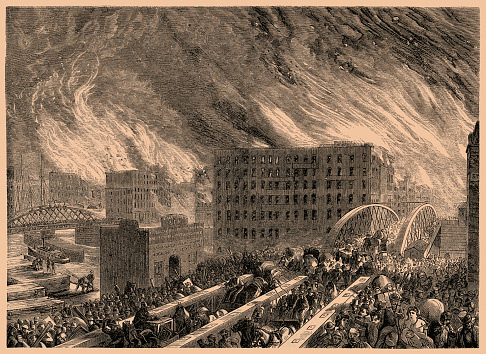From the Chief’s Corner: Who’s Really at Risk When There Is No Communications...

Posted on March 4, 2021
Many of you have heard me say many times, the issue of providing in-building communications is about protecting the public and public safety. The other night, I was working in my shop and the NBC series Chicago Fire was on the television. I was kind of half listening when I heard something important that caught my attention.
One of the characters of the show, Lieutenant Herrman said these words; “hey Chief, it's Herrman. Cruz and I are trapped in the elevator somewhere between the seventh and eighth floor. Chief, you copy?” I immediately stopped what I was doing and hit rewind on the remote to see what was really taking place.
Setting the stage: A possible fire had been reported on the upper floor of a high-rise building where some construction was taking place. When Lieutenant Herrman and firefighter Cruz entered the building, they decided to ride up in the elevator and then get out a few floors below the fire floor and walk up the stairs the final distance to the fire floor. After closing the elevator door and beginning their journey something critical happened that caused the elevator to stop and fall several feet. When this occurred, a civilian construction worker, also on the elevator, was injured. So now the firefighters were trapped and had an injured civilian who needed medical treatment along with another civilian who was the buildings property manager.
Now remember, its 2021 and every firefighter has their own portable radio so all they needed to do is call for help right?
So that is exactly what Lieutenant Herrman did. Here is what was said over the next few minutes, “hey Chief, it's Herrman. Cruz and I are trapped in the elevator somewhere between the seventh and eighth floor. Chief, you copy?” Then the civilian said, “Now your radio doesn’t work either,” and Lieutenant Herrman replied, “these old buildings are made of concrete and steel and wreak havoc on the signal.” Cruz adds, “especially in the stairways and elevator shafts.” Then the civilian adds an important statement to the conversation, “seems like you should have better technology.” Sound familiar???
Take a minute to Listen to the Actual Conversation:
NBC’s Chicago Fire Series - Season 5 Episode 9. Yes, I know this is television and everything you see there is not real. However, what is so critical to understand here is that the exact situation Lieutenant Herrman, Cruz and the civilians find themselves in, (no cellular or land mobile radio communication) during an emergency incident occurs somewhere, every day for our first responders and the public they serve. The reality is people really are at risk when communications does not exist.
The Legislative Climate:
Just this week, I have been in conversations where policymakers are wanting to pass laws to eliminate, reduce or delay the requirements for having in-building public safety communications enhancement solutions. In other words, placing cost of construction above that of providing critical life safety solutions within buildings. So how do we manage this type of conversation or thought process.
Well for that, I want to take you on a journey down memory lane for a minute to understand a little bit about how fire code regulations came into being, why they are important and why they need to continue to exist for a safer built environment. History has a significant impact on us and understanding it provides many opportunities to quite simply, do better. Remember George Santayane once said; “Those who do not remember the past are condemned to repeat it.
So, since I started with a clip from Chicago Fire the TV series, I am going to keep this history lesson about who is really at risk from events that also took place in the windy city.
Tragedy Leads to Change:
When one hears the words Chicago Fire there may be several thoughts that may come to mind. For example, The Chicago Fire of 1871 which is also commonly referred to as the Great Chicago Fire wreaked havoc across the windy city burning everything in its path. It is estimated that approximately 300 people lost their lives and over 100,000 people were left homeless due to the fire. It was determined that the massive fire left a devastated path 4 miles long and 1 mile wide.
Within that path, the fire consumed thousands of buildings and other properties with an estimated damage of $200 million. Now remember this was in 1871 and that was a significant amount of money. What we know about buildings during that time is that most of them were constructed of wood and were built in close proximity to each other.
The Great Chicago Fire started in a barn located on Chicago’s southwest side of the city on DeKoven Street. The barn was owned by Mr. Patrick O’Leary and his wife Catherine. The fire started on evening of October 8, 1871 and burned until October 10, 1871. The massive fire spread so fast that it created tornado-style winds, jumping streets and other open areas within the city. Legends surrounding the fire say that a cow owned by O’Leary knocked over a lighted lantern which ignited the fire. However, the official source of the fire is not truly known, but what we do know is that many lessons were learned about fire safety and construction practices.
Jumping forward a few decades to 1903, there was another significant fire that occurred in the Iroquois Theater in Chicago. On December 30, 1903, the Iroquois Theater fire took the lives of 602 people and was the deadliest theater fire in United States history. Contributing to the deadly fire were blocked and locked fire exits and the lack of an adequate fire safety plan. One interesting point about the Iroquois Theater is that in November of that same year a local building commissioner and fire inspector inspected the site and declared that it was “fireproof”. The building was also evaluated by the editor of Fireproof magazine and in his editorial about fire dangers he commented on the fact that the building lacked a fire alarm or fire sprinkler system. The deadly fire forced Chicago officials to take a hard look at how they inspected and regulated large public assembly spaces within the city.
Fifty-five years later, on the afternoon of December 1, 1958, another tragedy struck Chicago at a grade school operated by the Sisters of Charity. That tragedy took place at the Our Lady of Angels School where over 1600 students were enrolled. The school, which was a large, older building did little in the way of fire prevention. There were no fire sprinklers and routine fire drills were not conducted. What began as a small fire in a trash pile in the basement led to a horrific disaster that claimed the lives of 92 students and 3 nuns.
So, what do these tragic events have to do with in-building Emergency Responder Radio Communications Enhancement Systems (ERCES)? You might be thinking that when you look at these dates 1871, 1903 and 1958, radios were not even a real thought much less an issue inside the buildings. And yes, you would be correct. But what was known when each of these events took place was the fact that fire is deadly for both building occupants and first responders.
In the tragedies and loss of countless lives of the Great Chicago Fire, the Iroquois Theater Fire, the Our Lady of Angels School Fire and many others like them, people eventually took note of the real dangers of fire. Many of the lessons learned led to enhanced fire safety and fire prevention measures. For example, following the Iroquois Theater Fire, the Chicago City Council passed new building ordinances by an overwhelming majority that included new standards for exits and aisles, fireproofing solutions for onstage scenery, limits on occupancy, fire alarms and sprinkler requirements, among others. But that was after 602 people had already died.
Lessons Learned:
As it relates to in-building communications we cannot repeat that vital history lesson by allowing multiple tragedies to occur before we wake up and realize that the lack of in-building communications is a real issue for the public and public safety responders.
When I think about the current legislative discussions taking place today, I can just image a similar conversation taking place in some back room amongst policymakers in 1871, 1903 and 1958. Someone probably saying, “This is not needed, fire and life safety requirements do nothing but increase cost, it will not happen here.” But you know what? The conversation DID occur, and the same thing can happen again if we are not vigilant in maintaining a voice for each and every first responder whose lives depend on that radio working when they need it most.
Now, I would be remiss if I did not once again point out that it is not as simple as providing a plug and play solution into every building. It is vitally important that whatever type of in-building solution (and there is more than one) is chosen has been reviewed and approved by not just the AHJ/fire code official but also the Frequency License Holder. Why you ask? Because that is the law, and it is contained within the Federal Communications Commission regulation 90.219. Involving paramount to the concept of First, Do No Harm…
In closing, I want to say that I am grateful that so many of you do what you do to ensure that the public and public safety responders’ risk are reduced by have a working communications system when they need it most. Each of you truly make a difference in ensuring that the real heroes that Lieutenant Herrman and firefighter Cruz portray in the NBC Chicago Fire series, along with our law enforcement and Emergency Medical Service personnel, go home every day at the end of their shifts.
As Stephen Covey said, “The main thing is to keep the main thing the main thing.” For us, that is ensuring reliable in-building communications exist so that people “Feel Safe Inside®”
|

